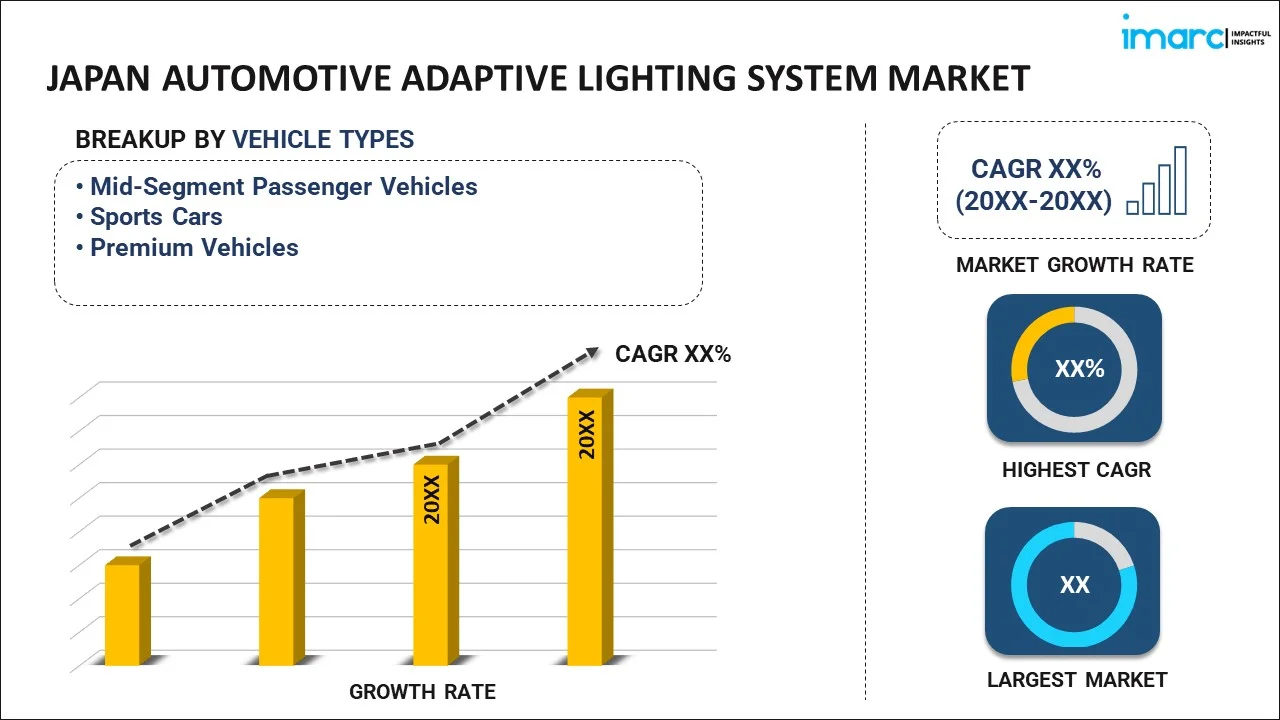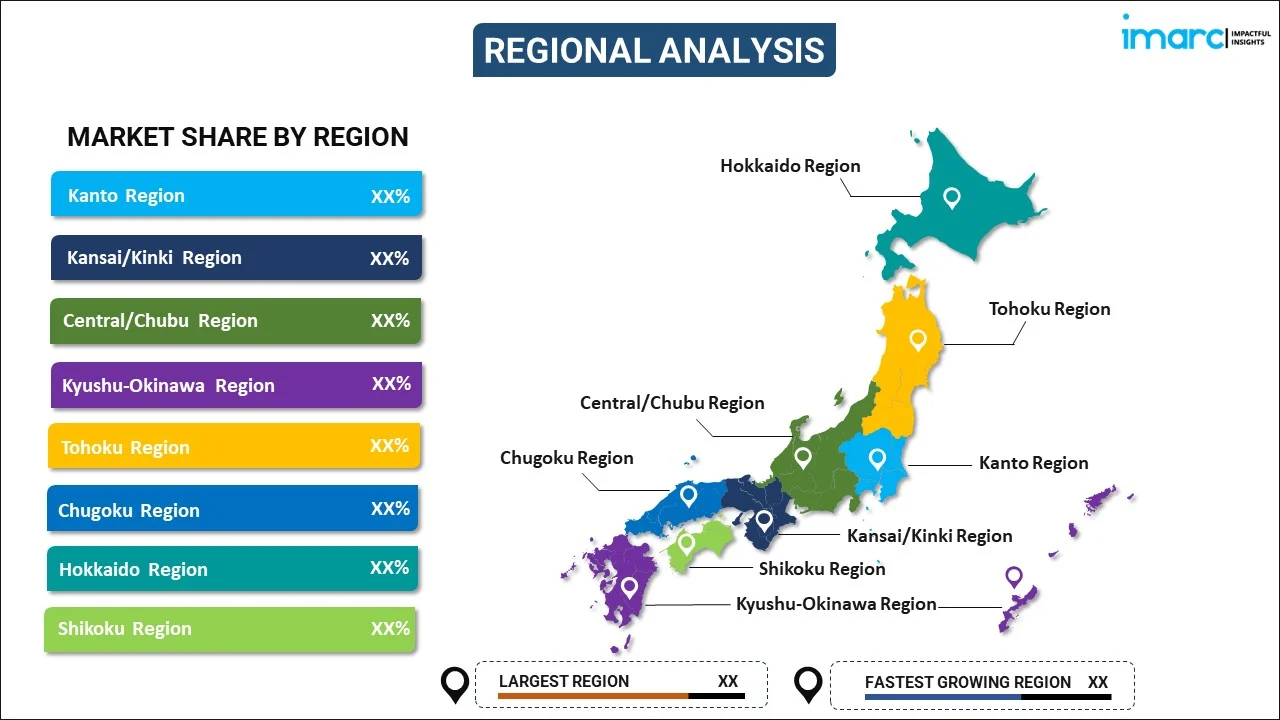
Japan Automotive Adaptive Lighting System Market Report by Vehicle Type (Mid-Segment Passenger Vehicles, Sports Cars, Premium Vehicles), Type (Front, Rear), Sales Channel (OEM, Aftermarket), and Region 2025-2033
Market Overview:
Japan automotive adaptive lighting system market size reached USD 80.0 Million in 2024. Looking forward, IMARC Group expects the market to reach USD 100.0 Million by 2033, exhibiting a growth rate (CAGR) of 3% during 2025-2033. The growing number of road accidents is propelling the need for advanced safety systems and features, which is primarily driving the market growth.
|
Report Attribute
|
Key Statistics
|
|---|---|
|
Base Year
|
2024
|
|
Forecast Years
|
2025-2033
|
|
Historical Years
|
2019-2024
|
|
Market Size in 2024
|
USD 80.0 Million |
|
Market Forecast in 2033
|
USD 100.0 Million |
| Market Growth Rate 2025-2033 | 3% |
An automotive adaptive lighting system is a revolutionary advancement in vehicular safety and functionality, specifically designed to enhance illumination and visibility under varying driving conditions. It operates intuitively, adjusting the range and width of the car's lights based on the vehicle's speed, steering, and elevation of the headlights, optimizing illumination in every scenario, whether it is a sharp turn or a steep hill. An automotive adaptive lighting system employs sophisticated sensors and electronics to analyze the external environment and the vehicle’s maneuvers in real-time, allowing for immediate modifications to the light pattern. It has the ability to ensure improved visibility during nighttime and inclement weather, thereby significantly reducing the risk of accidents and collisions. The integration of adaptive lighting is indicative of the automotive industry's ongoing pursuit of innovations that amalgamate enhanced safety with superior technology.
Japan Automotive Adaptive Lighting System Market Trends:
The Japan automotive adaptive lighting system market is experiencing substantial growth, influenced by the expanding automotive sector renowned for technological innovations. It is primarily propelled by an escalating demand for advanced safety features, driven by heightened consumer awareness and stringent safety regulations within the region. The incorporation of adaptive lighting systems in vehicles is gaining momentum in response to the rising emphasis on road safety and the prevalence of night-time driving conditions. Apart from this, the elevating consumer preference towards technologically superior and premium vehicles is acting as another significant growth-inducing factor. Additionally, the advent of electric and autonomous automobiles in Japan is bolstering the market, fostering advancements in adaptive lighting, contributing to the system's enhanced efficiency and compatibility with contemporary vehicle architectures. The integration of cutting-edge technologies, such as Artificial Intelligence (AI) and the Internet of Things (IoT), stands as a significant trend, marking a move towards real-time adaptability and enriched performance. Furthermore, sustainability drives the market with a push towards the development of eco-friendly lighting solutions, aligning with the broader environmental conservation objectives of the Japanese automotive industry. The ongoing developments will continue to catalyze the Japan automotive adaptive lighting system market in the coming years.
Japan Automotive Adaptive Lighting System Market Segmentation:
IMARC Group provides an analysis of the key trends in each segment of the market, along with forecasts at the country level for 2025-2033. Our report has categorized the market based on vehicle type, type, and sales channel.
Vehicle Type Insights:

- Mid-Segment Passenger Vehicles
- Sports Cars
- Premium Vehicles
The report has provided a detailed breakup and analysis of the market based on the vehicle type. This includes mid-segment passenger vehicles, sports cars, and premium vehicles.
Type Insights:
- Front
- Rear
A detailed breakup and analysis of the market based on the type have also been provided in the report. This includes front and rear.
Sales Channel Insights:
- OEM
- Aftermarket
The report has provided a detailed breakup and analysis of the market based on the sales channel. This includes OEM and aftermarket.
Regional Insights:

- Kanto Region
- Kansai/Kinki Region
- Central/ Chubu Region
- Kyushu-Okinawa Region
- Tohoku Region
- Chugoku Region
- Hokkaido Region
- Shikoku Region
The report has also provided a comprehensive analysis of all the major regional markets, which include Kanto Region, Kansai/Kinki Region, Central/ Chubu Region, Kyushu-Okinawa Region, Tohoku Region, Chugoku Region, Hokkaido Region, and Shikoku Region.
Competitive Landscape:
The market research report has also provided a comprehensive analysis of the competitive landscape in the market. Competitive analysis such as market structure, key player positioning, top winning strategies, competitive dashboard, and company evaluation quadrant has been covered in the report. Also, detailed profiles of all major companies have been provided.
Japan Automotive Adaptive Lighting System Market Report Coverage:
| Report Features | Details |
|---|---|
| Base Year of the Analysis | 2024 |
| Historical Period | 2019-2024 |
| Forecast Period | 2025-2033 |
| Units | Million USD |
| Scope of the Report | Exploration of Historical and Forecast Trends, Industry Catalysts and Challenges, Segment-Wise Historical and Predictive Market Assessment:
|
| Vehicle Types Covered | Mid-Segment Passenger Vehicles, Sports Cars, Premium Vehicles |
| Types Covered | Front, Rear |
| Sales Channels Covered | OEM, Aftermarket |
| Regions Covered | Kanto Region, Kansai/Kinki Region, Central/ Chubu Region, Kyushu-Okinawa Region, Tohoku Region, Chugoku Region, Hokkaido Region, Shikoku Region |
| Customization Scope | 10% Free Customization |
| Post-Sale Analyst Support | 10-12 Weeks |
| Delivery Format | PDF and Excel through Email (We can also provide the editable version of the report in PPT/Word format on special request) |
Key Questions Answered in This Report:
- How has the Japan automotive adaptive lighting system market performed so far and how will it perform in the coming years?
- What has been the impact of COVID-19 on the Japan automotive adaptive lighting system market?
- What is the breakup of the Japan automotive adaptive lighting system market on the basis of vehicle type?
- What is the breakup of the Japan automotive adaptive lighting system market on the basis of type?
- What is the breakup of the Japan automotive adaptive lighting system market on the basis of sales channel?
- What are the various stages in the value chain of the Japan automotive adaptive lighting system market?
- What are the key driving factors and challenges in the Japan automotive adaptive lighting system?
- What is the structure of the Japan automotive adaptive lighting system market and who are the key players?
- What is the degree of competition in the Japan automotive adaptive lighting system market?
Key Benefits for Stakeholders:
- IMARC’s industry report offers a comprehensive quantitative analysis of various market segments, historical and current market trends, market forecasts, and dynamics of the Japan automotive adaptive lighting system market from 2019-2033.
- The research report provides the latest information on the market drivers, challenges, and opportunities in the Japan automotive adaptive lighting system market.
- Porter's five forces analysis assist stakeholders in assessing the impact of new entrants, competitive rivalry, supplier power, buyer power, and the threat of substitution. It helps stakeholders to analyze the level of competition within the Japan automotive adaptive lighting system industry and its attractiveness.
- Competitive landscape allows stakeholders to understand their competitive environment and provides an insight into the current positions of key players in the market.
Need more help?
- Speak to our experienced analysts for insights on the current market scenarios.
- Include additional segments and countries to customize the report as per your requirement.
- Gain an unparalleled competitive advantage in your domain by understanding how to utilize the report and positively impacting your operations and revenue.
- For further assistance, please connect with our analysts.
 Inquire Before Buying
Inquire Before Buying
 Speak to an Analyst
Speak to an Analyst
 Request Brochure
Request Brochure
 Request Customization
Request Customization




.webp)




.webp)












